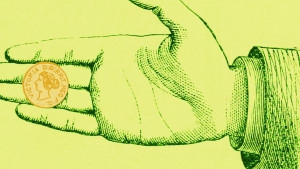Inside The ICO Bubble: Why Initial Coin Offerings Have Raised More Than $1 Billion Since January
By Steven Melendez , July 28, 2017
Earlier this month, the people behind a software project called Tezos raised more than $230 million in a roughly two-week fundraiser.
But they weren’t selling shares in a company, or even working through a crowdfunding platform like Kickstarter. Instead, the group, which plans to set up a digital ledger system and cryptocurrency similar to bitcoin or ethereum, organized what digital finance research firm Smith and Crown says was the largest so-called initial coin offering in history. They offered backers virtual tokens that will be usable as currency on the platform once it gets off the ground, which is expected to happen later this year, in exchange for bitcoin and ethereum.
“What people did is they made a contribution to an open source project that they believe in,” says Johann Gevers, a Switzerland-based digital finance entrepreneur and a member of a Swiss foundation created to support Tezos. “This is not a traditional investment where people get equity in a company and they have dividends and voting rights and so forth—there is absolutely no relationship like that.”
Similar offerings have raised more than $1.2 billion since the start of this year, according to data from Smith and Crown, with founders and leaders of startups and open source projects trading newly created digital tokens for ethereum and bitcoin. Some startups have even gone to the ICO market after raising money from traditional venture capitalists, and the market has attracted attention from high-profile investors like Mark Cuban and boxer Floyd Mayweather.
Some projects, like Tezos, seek to create their own blockchains–the cryptographically secure shared ledgers that log transactions in digital currencies–and offer improvements on those used by existing coins.
Others offer services geared toward users of cryptocurrencies, like easy-to-use online trading systems and banks for the new money systems. And still others offer digital tokens that can be used in the tangible world. In June, a project called Primalbase raised more than 3,000 bitcoin, or about $8 million at current exchange rates, in just 24 hours, selling virtual tokens that grant access to a forthcoming chain of coworking spaces. And a project known as ZrCoin reported raising more than $7 million selling tokens to finance a plant in Russia to produce zirconium dioxide–which is used in ceramics–from industrial waste. Those founders say they plan to buy the coins back from investors—or allow them to swap a token for a kilogram of zirconium dioxide.
“It’s a very flexible instrument—it can be connected to equity, to debt,” says Sasha Ivanov, founder of the Waves blockchain platform, where ZrCoin and Primalbase tokens were sold, of digital tokens. “You cut out all the middlemen, so it’s more cost effective, ’cause you can really go to the public directly.”
Initial coin offerings didn’t appear this year: Around 2014, when bitcoin prices first topped $1,000, a wave of rival cryptocurrencies known as altcoins entered the marketplace. Most quickly disappeared, or saw their values drop to near zero. But since January, a new wave of offerings has already raised than ten times as much as was raised in all of 2016, according to Smith and Crown–with at least three projects raising more than $100 million.
“Those are incredible numbers,” says Stan Miroshnik, CEO of the Element Group, which provides investment bank-style advice and services to groups launching coin offerings. “Those are IPO-level numbers in the public market.”
The coin offering market particularly took off after ethereum and bitcoin rose sharply in value this year, leaving the cryptocurrency enthusiasts most comfortable investing in such projects suddenly flush with digital cash. Ethereum also made it easier to create new digital tokens through its support for smart contracts. Those are bits of code written by ethereum users that can transfer currency under certain circumstances, like when payment is due on a loan, or keep track of who holds other, newly created virtual tokens. A standard called ERC20 sets a common interface for smart contracts handling tokens on the ethereum network, letting coin-managing wallet software and other programs already familiar to successful ethereum investors handle new tokens without the need for special adaptations.
“They have a lot of resources to play with, and investing it in tokens or the other parts of the ecosystem is a pretty logical space,” says Matt Chwierut, research director at Smith and Crown.
But investing in digital tokens is unlike putting money into stocks or mutual funds.The coins are, at least at the moment, essentially unregulated, though the Securities and Exchange Commission recently signaled that some likely fall under the purview of U.S. securities law. Teams utilizing coin offerings often raise money at much earlier stages than traditional companies turn to the public markets. They frequently offer mathematically intensive white papers and public GitHub repositories with proof-of-concept code in lieu of slick prospectuses and audited financial statements. In some ways, the market more closely resembles crowdfunding platforms like Kickstarter or Indiegogo, though high-raising projects such as Tezos dwarf even the most lucrative Kickstarter fundraisers, like those for Pebble smartwatches or the Veronica Mars movie, by an order of magnitude.
And since the offerings take place outside of regulated markets or commercial fundraising sites, there’s little vetting being done of projects seeing support, besides that being done by investors themselves.
“There’s just not a lot of regulatory clarity on what kinds of claims projects themselves can make, and people who are participating in these types of opportunities need to be very cautious, and of course not contribute or invest more than people can afford to lose,” says Chwierut.
“It is most likely that some of these projects will fail—just like an angel investor or a seed stage venture capitalist or even someone who participates in a Kickstarter campaign, things they fund will fall apart.”
The blockchain world has also been affected by a series of high-profile hacks—virtual heists striking everything from cryptocurrency exchanges to wallet software to ICOs themselves. Last June, a project called the Distributed Anonymous Organization, or DAO, raised more than $150 million on the ethereum network, planning to let investors vote on how to invest the funds in other projects. But a defect in the DAO’s code let hackers steal much of the invested money, an attack only averted when ethereum users patched the network’s own code to let investors recover their funds.
More recently, cryptocurrency trading platform CoinDash saw about $7 million fraudulently diverted from its own coin offering after scammers hacked the project’s website to direct investors to transfer funds to the wrong virtual address.
And in July, at least three post-ICO projects—commerce platform Swarm City, casino Edgeless, and blockchain platform Aeternity—lost a collective 153,000 ethereum, now worth about $30 million, after hackers exploited a bug in common wallet software.
Each project said it would continue to develop its platform even after the theft.
“Black hat hackers, vulnerabilities, and bugs will not stop us from creating the decentralized sharing economy our community and the world craves,” the Swarm City founders said in a Medium post.
Even many people in the cryptocurrency sector acknowledge some tokens are overvalued.
“Of course there’s a bubble,” says Ivanov. “Definitely.”
But advocates argue there will be a place for the digital tokens long-term, even if the current wave of enthusiasm subsides. Tokens can be used to represent credit held in other online systems, from video games to any sort of prepaid services, or even to track ownership of real-world assets from gold to real estate. And they enable fledgling startups, and even more loosely structured projects, to raise funds effectively on their own terms, at least to the extent future regulation permits.
“I think token sales make too much sense at this point to really go away,” Chwierut says. “The advantages this represents to seek to do any of the following—raise capital, build community, and attract early users—is just too great to totally deny.”
Blockchain enthusiasts are rushing to ICOs–but like all prospectors through the ages, those who back virtual tokens face a slew of risks.
Earlier this month, the people behind a software project called Tezos raised more than $ 230 million in a roughly two-week fundraiser.
Fast Company , Read Full Story
(29)






